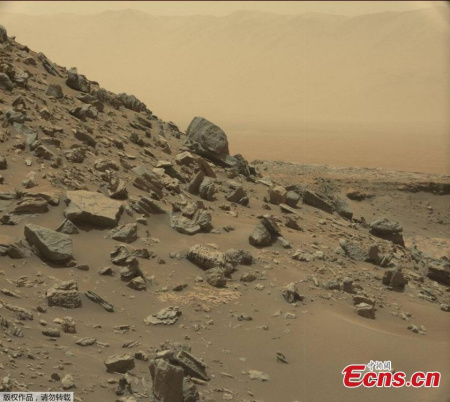
This image take by NASA's Curiosity Mars Rover shows a dramatic hillside outcrop with sandstone layers. (Photo/NASA)
U.S. space agency NASA said Friday its 12-year-old Opportunity Mars rover will explore a gully carved long ago by a fluid that might involve water, a feat that has never been done by a Mars rover before.
"Fluid-carved gullies on Mars have been seen from orbit since the 1970s, but none had been examined up close on the surface before," Opportunity Principal Investigator Steve Squyres of Cornell University said in a statement.
"We hope to learn whether the fluid (that carved this gully) was a debris flow, with lots of rubble lubricated by water, or a flow with mostly water and less other material."
Currently, Opportunity is exploring the "Bitterroot Valley" portion of the western rim of Endeavour Crater, a basin 22 kilometers in diameter that was excavated by a meteor impact billions of years ago.
Opportunity reached the edge of this crater in 2011 after more than seven years of investigating a series of smaller craters, where it found evidence of acidic ancient water that soaked underground layers and sometimes covered the surface.
According to NASA, the gully chosen as the next major destination slices west-to-east through the rim less than a kilometer south of the rover's current location and is about as long as two football fields.
The longest-active rover on Mars also will, for the first time, visit the interior of Endeavour Crater, according to the latest plans for Opportunity's two-year extended mission that began on Oct. 1.
The goal is to compare rocks inside the crater to the dominant type of rock Opportunity examined on the plains it explored before reaching Endeavour.
"We may find that the sulfate-rich rocks we've seen outside the crater are not the same inside," Squyres said. "We believe these sulfate-rich rocks formed from a water-related process, and water flows downhill. The watery environment deep inside the crater may have been different from outside on the plain -- maybe different timing, maybe different chemistry."
The third main science goal of the new extended mission is to find and examine rocks from a geological layer that was in place before the impact that excavated Endeavour Crater.
But NASA said the science team has not yet determined whether the mound area will provide rocks that old.
Opportunity landed on Mars in January 2004 on what was a three-month mission, but instead the rover has worked on the planet for about 12 years.
NASA said most mechanisms onboard still function well, but motors and other components have far exceeded their life expectancy.


















































